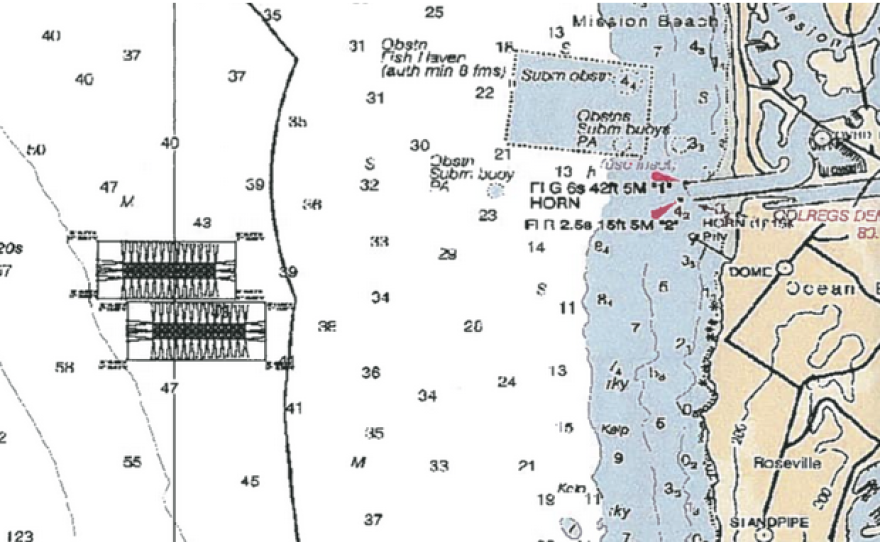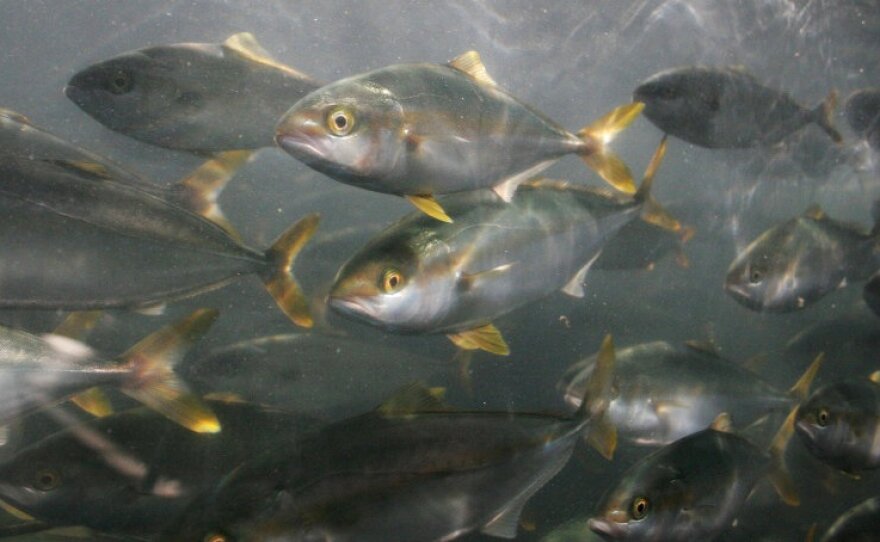Don Kent peers into a water tank about the size of a backyard swimming pool and watches as a school of 10 yellowtails swim by, each about 4 feet long.
“There are some big guys in there. There they come,” he said. “That’s a big fish right there.”
I ask if he has names for them.
“I try not to have names for things I eat,” he said.
Kent won’t be eating these fish, but he hopes we’ll all be chowing down on their offspring in a few years.
Kent is president and CEO of the Hubbs-SeaWorld Research Institute, a research nonprofit partially funded by SeaWorld. Hubbs-SeaWorld is partnering with a private investment firm to create the largest fish farm in America.
The proposed Rose Canyon Fisheries aquaculture project would be built 4 miles off San Diego's coast. It could have a footprint on the ocean floor that’s slightly smaller than Balboa Park, and could produce 11 million pounds of yellowtail and sea bass each year.
Kent said this country needs the project because 91 percent of its seafood is imported, and countries like China that produce a lot of fish are now keeping more for themselves.
“The price of seafood is going up higher and higher for people like us who have to import it,” he said. “So the big advantage we have over those other supplies is from the fact that we can grow it locally.”
But some environmentalists equate it to a large industrial farm.

How big is it?
Rose Canyon Fisheries would consist of 48 cages, each about 11,000 cubic meters, or 4.4 olympic swimming pools.

The cages would be divided into two grids that together cover an area about the same size as the parking lot around Qualcomm stadium.
Anchor lines would run from the cages to the bottom of the ocean. Those lines extend out, so the project’s footprint on the ocean floor would cover about 1.3 square miles.
The project would span the waters from Sunset Cliffs to Pacific Beach. Its cages could have poles that extend 16 feet above the water, but Kent said we won’t see them from shore. He has computer modeling that shows the cages will be below the horizon.
To test that out, I did some trigonometry. My calculations showed if you’re lying on the ground at the ocean’s edge, you’d see the top third of a 16-foot pole. If you’re standing up, you could see more.
Environmental group San Diego Coastkeeper is concerned about the scale of the project. They took out their boat 4 miles off of Ocean Beach and held up a pole. I went to Sunset Cliffs and looked for it.
The boat was visible, but looked like a small dot on the horizon. So passersby could maybe see a grid of 42 poles, but they also might not notice them.
Environmental concerns
Matt O’Malley, a lawyer with San Diego Coastkeeper, also took me out on the boat to the spot where Rose Canyon Fisheries would go. After 45 minutes of riding through very choppy waters, he cut the engine.
“You come out to a place like this, you can see how quiet, how pristine, how beautiful it is,” he said. Then he looked at the houses on shore.
“You just know that some of these people are going to be out here looking at this,” he said.
But O’Malley’s problems don’t end with beach homes’ views.
“We're talking about putting a floating factory farm right off the coast of San Diego,” he said.
O’Malley points out 11 million pounds of fish would create a lot of, well, fish poop, and said that waste could change the chemistry in the water below the farm and on the ocean floor, and could lead to algae blooms.
He also worries fish could escape the cages and spread diseases or breed with wild populations, hurting genetic diversity. Plus, he worries seals and sea lions would be attracted to all of those caged fish and get entangled in nets and ropes, and that the farm could change whale migrations and wild fish behavior.
Kent with the Hubbs-SeaWorld Research Institute doesn’t dispute calling the project an industrial farm, but doesn’t see that as a negative.
“If people were to sit down to their breakfast and say, I'm not going to eat anything farmed, then it's going to be a pretty light breakfast,” he said.
He said Rose Canyon Fisheries won’t hurt the environment. The project would use thick rope lines and plastic nets that won’t entangle marine mammals, he said. He also described computer modeling that shows the farm is in deep enough water to dilute the fish poop. The cages are designed so the fish won’t escape, he said, and even if they did they won’t have diseases to spread.
As for the inbreeding concern, he said the farm’s fish would be offspring of wild fish and that the farmed fish would be harvested before they breed with each other.
“You can create a brood stock bred for faster growth, but before we go down that road, we want to make sure escapement isn’t a problem,” he said. “We want to be sure inbred fish isn’t a threat to wild population.”
New ground for federal agencies
Kent said he’d scale up Rose Canyon Fisheries slowly over eight years and monitor its environmental impacts along the way.
But the project’s permits are for its full size. So if it’s approved, it could begin churning out more fish before the impacts are fully known.
While there are other fish farms in the United States, this is the first on this scale that will be built in federal waters, said Diane Windham, the 3rd Regional Aquaculture Coordinator at the National Oceanic and Atmospheric Administration. That means federal agencies, not California, will have ultimate authority over it.
But because Rose Canyon Fisheries is the first of its kind, there is not an established system for which agency will review its permits.
“There was a fairly lengthy, I don’t want to say debate, but thoughtful discussion about who should lead this,” Windham said.
It was recently decided that the Environmental Protection Agency will review whether the project follows the National Environmental Policy Act, with the National Oceanic and Atmospheric Administration (NOAA) adding input. The U.S. Army Corps of Engineers and the California Coastal Commission will also likely review portions of the project.
“A lot of people would assume NOAA has permitting authority because aquaculture is one of our national priorities and have a lot of expertise,” Windham said. “Everyone is learning as they go. This project definitely brought the issue to light as to why doesn’t NOAA have permitting authority and how could that be achieved.”
She said federal legislation could give her agency control over aquaculture projects. Right now the only proposed legislation regarding aquaculture is a bill from an Alaska congressman to ban fish farming entirely from federal waters.
NOAA has long been pushing for aquaculture projects in federal waters because state regulations are generally stricter, said food journalist Paul Greenberg.
The idea is to “go around state regulatory processes and speed up the process,” he said.
O’Malley with Coastkeeper called the permitting system a “regulatory black hole” and said Coastkeeper will do whatever it can to ensure the project is vetted, including suing if necessary.
“This is our backyard and this is a project that's massive, and has a lot of potential impact,” he said. “We think as a community, if we're going to be embarking on a project like this, we want to make damn sure the environment is protected in the process.”
Seafood swap
Kent hopes the project is approved soon to correct what he calls America’s seafood imbalance: exports to the U.S. are dwindling as the global population grows and more people eat fish.
But the United States does produce some fish. It’s just that Americans don’t always want to eat it. While 91 percent of this country’s seafood is imported, about one-third of the seafood Americans catch is sold to other countries.

That’s because imported seafood is often cheaper, and Americans tend to prefer the taste of foreign fish to the fish native to our coasts, journalist Greenberg said. His book American Catch describes a seafood swap.
“We tend to export stronger tasting things like mackerel, black cod, a lot of squid, and then we import shrimp, tilapia, neutral tasting things we can kind of deep fry and use in the American-palate-friendly sandwich,” he said.
Aquaculture can help correct this imbalance, but “rather than trying to start up new and complicated ventures, first off let’s try to eat the fish we’ve already got,” Greenberg said.
But aquaculture solves more global problems than Americans not liking fishy fish, Kent said.
“There's 7 billion people on earth now and there's going to be 9 billion people in your lifetime, very soon,” he said. “How are we going to feed those extra 2 billion people?”
One way to do that is through aquaculture, he said.






